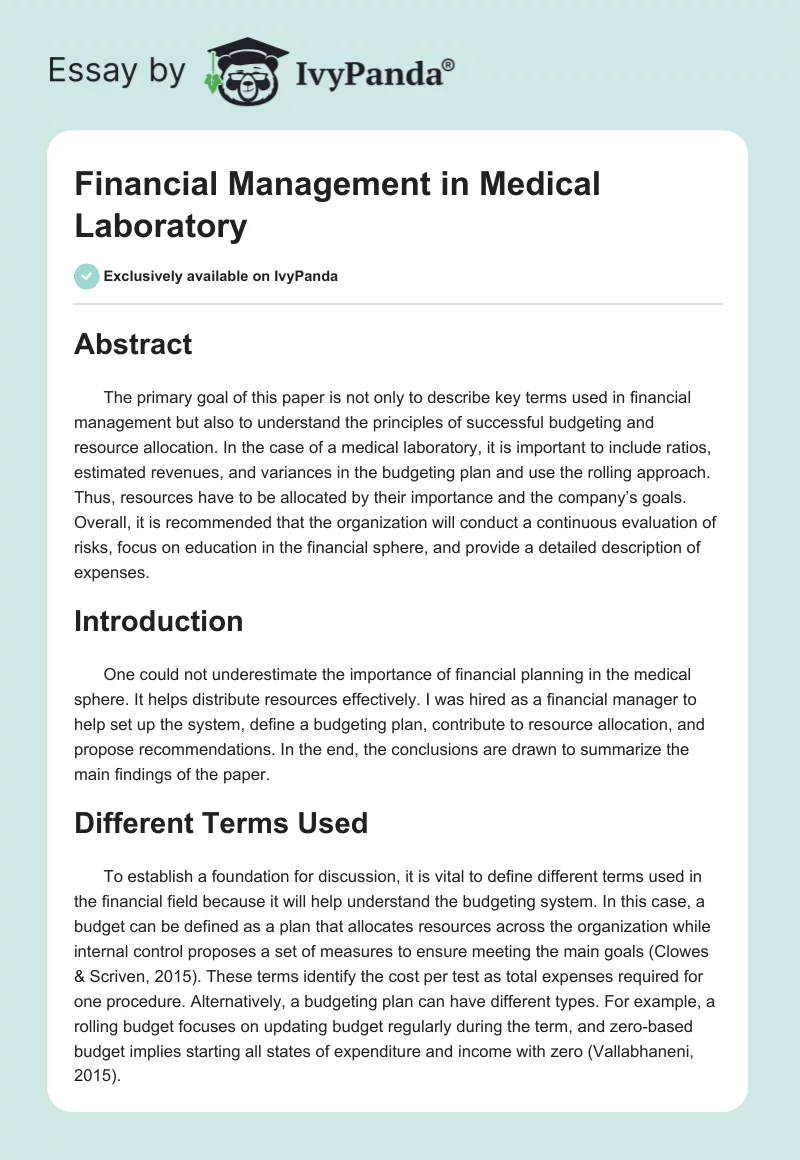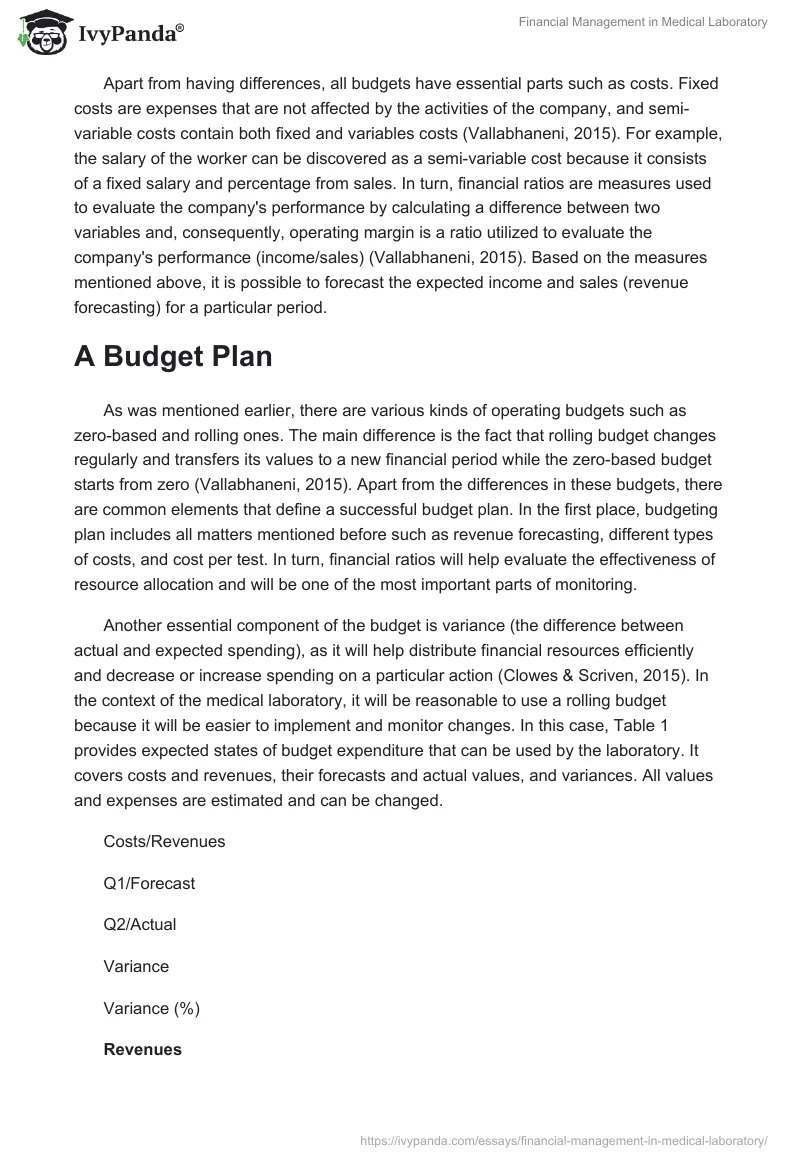Abstract
The primary goal of this paper is not only to describe key terms used in financial management but also to understand the principles of successful budgeting and resource allocation. In the case of a medical laboratory, it is important to include ratios, estimated revenues, and variances in the budgeting plan and use the rolling approach. Thus, resources have to be allocated by their importance and the company’s goals. Overall, it is recommended that the organization will conduct a continuous evaluation of risks, focus on education in the financial sphere, and provide a detailed description of expenses.
Introduction
One could not underestimate the importance of financial planning in the medical sphere. It helps distribute resources effectively. I was hired as a financial manager to help set up the system, define a budgeting plan, contribute to resource allocation, and propose recommendations. In the end, the conclusions are drawn to summarize the main findings of the paper.
Different Terms Used
To establish a foundation for discussion, it is vital to define different terms used in the financial field because it will help understand the budgeting system. In this case, a budget can be defined as a plan that allocates resources across the organization while internal control proposes a set of measures to ensure meeting the main goals (Clowes & Scriven, 2015). These terms identify the cost per test as total expenses required for one procedure. Alternatively, a budgeting plan can have different types. For example, a rolling budget focuses on updating budget regularly during the term, and zero-based budget implies starting all states of expenditure and income with zero (Vallabhaneni, 2015).
Apart from having differences, all budgets have essential parts such as costs. Fixed costs are expenses that are not affected by the activities of the company, and semi-variable costs contain both fixed and variables costs (Vallabhaneni, 2015). For example, the salary of the worker can be discovered as a semi-variable cost because it consists of a fixed salary and percentage from sales. In turn, financial ratios are measures used to evaluate the company’s performance by calculating a difference between two variables and, consequently, operating margin is a ratio utilized to evaluate the company’s performance (income/sales) (Vallabhaneni, 2015). Based on the measures mentioned above, it is possible to forecast the expected income and sales (revenue forecasting) for a particular period.
A Budget Plan
As was mentioned earlier, there are various kinds of operating budgets such as zero-based and rolling ones. The main difference is the fact that rolling budget changes regularly and transfers its values to a new financial period while the zero-based budget starts from zero (Vallabhaneni, 2015). Apart from the differences in these budgets, there are common elements that define a successful budget plan. In the first place, budgeting plan includes all matters mentioned before such as revenue forecasting, different types of costs, and cost per test. In turn, financial ratios will help evaluate the effectiveness of resource allocation and will be one of the most important parts of monitoring.
Another essential component of the budget is variance (the difference between actual and expected spending), as it will help distribute financial resources efficiently and decrease or increase spending on a particular action (Clowes & Scriven, 2015). In the context of the medical laboratory, it will be reasonable to use a rolling budget because it will be easier to implement and monitor changes. In this case, Table 1 provides expected states of budget expenditure that can be used by the laboratory. It covers costs and revenues, their forecasts and actual values, and variances. All values and expenses are estimated and can be changed.
Table 1. Budgeting plan.
Apart from the well-described budget, some problems exist. For example, Table 1 shows that sometimes there is a high variance between expected and actual costs. These differences take place because there may be some unexpected changes in prices and regulations. Nonetheless, this issue can be resolved with the help of regular evaluation of these changes, careful monitoring, and saving money for emergency (Shim, 2016). At the same time, other problems may be related to ineffective tracking of the procedures and resource allocation. Nonetheless, these issues can be resolved by continuous monitoring and financial ratios (Shim, 2016).
Resource Allocation
Resource allocation process is highly important because problems with it may lead to difficulties in planning. In the first place, it is reasonable to divide the required resources by categories such as maintenance expenses, reagents, and insurance and describe them in details (Raynus, 2016). This step is vital, as it will identify critical states of expenditure (see Table 1 for resource allocation). After that, ranking and prioritizing categories can be considered as significant, as, it will support company’s strategy and mission. Nonetheless, analysis of spending in the past quarters and changes in the business sphere can also be discovered as valuable. It will assist in estimating expenses, revenues, and decreasing variance.
Based on the evaluation conducted above, effective policies for future budgeting can be introduced. In the first place, the management has to develop goals and describe financial categories (Shim, 2016). This policy implies that financial resources have to be divided based on their relation to final products. Next step is defining measures (ratios) that will be used to monitor progress and ensure that the resources are allocated successfully. For example, the acceptable variance should be no more than 10%. Lastly, there is always a need for finances for emergencies to avoid losses (Wesley & Wanat, 2016).
Recommendations
In general, the management of the company has to reflect its main values in its budget. This information can be used as a basis to evaluate and rank the resources. At the same time, regular analysis of changes and detailed description of all activities can help avoid common financial issues. They are related to the ineffective distribution of resources and high variances in planned and actual budgets. Alternatively, apart from the described strategies, it is critical to pay attention to different monitoring and control tools (financial ratios). These measures will help spot problems at the beginning. Thus, expanding knowledge in this area can help avoid financial issues. Based on this analysis, management has to focus on continuous education, evaluation of risks, and organization of finances.
Conclusion
In the end, for management, it is important to understand the key terms and accounting principles employed by the organization. Using the ideas of rolling budget is the easiest approach, and including variance will help distribute and plan resources effectively. As for resource allocation, focusing on company’s goals, evaluating the significance of different categories, and monitoring (financial ratios) will help distribute finances successfully. Overall, a combination of these factors can be considered as recommendations to improve the financial performance of the company and decrease the impact of different problems.
References
Clowes, R., & Scriven, V. (2015). Budgeting: A practical approach. London, UK: Pearson Higher Education.
Raynus, J. (2016). Improving business process performance: Gain agility, create value, and achieve success. Boca Raton, FL: CRC Press.
Shim, J. (2016). Accounting and finance for the non-financial executive: An integrated resource management guide for financial executive. Boca Raton, FL: CRC Press.
Vallabhaneni, S. (2015). Wiley CIAexcel exam review: Focus notes 2015. Hoboken, NJ: John Wiley & Sons.
Wesley, R., & Wanat, J. (2016). A guide to internal loss prevention. Amsterdam, Netherlands: Elsevier.


